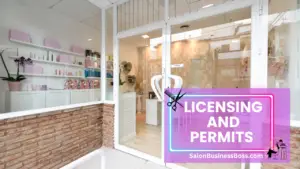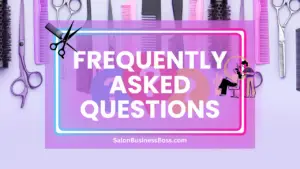Starting a hair salon can be an exciting venture for aspiring entrepreneurs passionate about the beauty industry. However, like any business, it requires careful planning and financial considerations.
Starting a hair salon involves an estimated cost of about $27,000. This includes rent, equipment, interior design, licenses, marketing, staff, and utilities. Thorough planning is crucial for success in the competitive beauty industry.
1. Location and Rent
Selecting the ideal location is undeniably one of the most pivotal decisions when embarking on the journey of starting a hair salon. The location can profoundly influence the salon’s success, as it directly impacts foot traffic, visibility, and accessibility. A prime, high-traffic location often translates to increased walk-ins and potential clients, providing a valuable head start for the new salon. Such bustling areas can become the epicenter of style and beauty, attracting a diverse customer base and fostering a vibrant atmosphere that naturally draws people in.
However, the allure of a prime location is accompanied by a higher price tag. Monthly rent for a small salon space can range from $1,000 to $3,000, and in some popular city centers, it may even be higher. The cost varies based on the city’s size, economic status, and the particular neighborhood’s desirability. For salon owners, it is essential to carefully assess their budget and financial projections to determine the most viable location that balances cost and potential revenue.
Finding the right equilibrium between cost and potential foot traffic is a delicate task, as an expensive location might strain the initial budget, while a less expensive location with limited visibility might hinder attracting a sufficient clientele. Extensive market research and a clear understanding of the target audience can help salon owners make an informed decision about the location that aligns with their business goals and ensures long-term success.
2. Salon Equipment and Furniture
Equipping a hair salon with the necessary tools and furniture is a significant investment that directly impacts the salon’s efficiency and customer experience. Basic equipment essential for a functional salon includes hairstyling chairs, shampoo stations, hairdryers, and styling tools. These items can collectively cost anywhere from $5,000 to $10,000, depending on the quality and brand chosen. Investing in high-quality equipment is crucial to ensure durability and safety, as well as to deliver top-notch services to clients.
Creating a comfortable and welcoming atmosphere for clients is equally important. The waiting area should be furnished with comfortable seating, stylish and well-positioned mirrors, and adequate storage solutions for clients’ belongings. Allocating a portion of the budget, typically around $1,000 to $3,000, for comfortable furniture and well-designed storage solutions will help create a positive first impression and contribute to customer satisfaction.
3. Salon Interior Design
The interior design of a hair salon plays a pivotal role in setting the tone and ambiance of the space. Creating an aesthetically pleasing and functional environment is crucial for attracting and retaining customers. While it may add to the overall cost, enlisting the expertise of a professional interior designer can elevate the salon’s appearance and overall experience for both clients and staff.
A budget of approximately $2,000 to $5,000 is reasonable for interior design, which covers elements like paint, lighting, décor, and fixtures. A well-thought-out color scheme, suitable lighting, and tasteful décor can transform the salon into an inviting and relaxing space, making clients feel comfortable and pampered during their visits.
Collaborating with an interior designer also ensures that the layout maximizes the available space efficiently, providing ample room for stylist workstations, client seating, and other necessary areas. A cohesive and visually appealing design creates a positive impression on clients, boosting their confidence in the salon’s professionalism and dedication to providing exceptional services. Ultimately, investing in a thoughtfully designed salon interior contributes significantly to the overall success and reputation of the hair salon.
4. Licensing and Permits

Operating a hair salon legally necessitates obtaining various licenses and permits. The specific requirements and costs can vary depending on the salon’s location and the local regulations in place. Generally, salon owners can expect to spend around $500 to $1,000 on licenses, permits, and other related legal fees.
The types of licenses and permits needed may include a general business license, a salon-specific permit, health department approvals, and zoning permits. It is essential to research the specific licensing requirements in the area where the salon will be established to ensure compliance with all relevant laws and regulations.
Staying updated on any changes to licensing regulations is crucial to avoid potential fines or legal issues in the future. Seeking legal advice or consulting with local authorities can help salon owners navigate the licensing process smoothly and efficiently.
Complying with all necessary licensing and permit requirements not only ensures the salon’s legality but also builds trust with clients, demonstrating a commitment to operating a reputable and professional establishment.
Read more about: How to Start a Nail Salon and Spa
5. Inventory and Products
Stocking the salon with high-quality hair products, shampoos, conditioners, and styling products is paramount for providing exceptional services and maintaining a positive reputation. Allocating a budget of around $1,500 to $3,000 for initial inventory purchases allows the salon to offer a wide range of options to cater to diverse client needs.
Building strong relationships with reputable suppliers can be advantageous, as it may lead to better deals, discounts, and favorable payment terms. Regularly evaluating and updating the inventory to align with market trends and customer preferences is also vital for staying competitive in the industry.
Investing in premium products can enhance the salon’s image, as clients will perceive the commitment to quality and be more likely to return for repeat visits. Additionally, providing professional-grade products for retail sale to clients can create an additional revenue stream for the salon.
By carefully managing inventory and product offerings, salon owners can strike a balance between meeting client demands, maintaining stock levels, and optimizing profitability in the long run.
6. Marketing and Advertising
In the highly competitive beauty industry, effective marketing and advertising are crucial for attracting customers and building a loyal clientele. Allocating a budget of approximately $1,500 to $3,000 for marketing expenses in the initial months allows the salon to establish a strong online and offline presence.
Creating a professional website is essential for showcasing the salon’s services, pricing, and contact information. Utilizing social media platforms can help engage with potential clients, share updates, and display before-and-after photos to demonstrate the salon’s expertise.
Investing in traditional advertising methods, such as distributing flyers, brochures, and business cards, can also boost brand visibility within the local community. Collaborating with influencers or partnering with nearby businesses can further expand the salon’s reach and attract a broader audience.
Consistency is key in marketing efforts, and regular updates on social media, blogs, and promotions can keep clients informed and engaged. Tracking marketing performance through analytics and customer feedback enables salon owners to refine strategies and make data-driven decisions for continued growth.
By proactively promoting the salon’s services and showcasing its unique selling points, marketing efforts can help position the salon as a go-to destination for haircare needs, ultimately contributing to its long-term success.
7. Salon Staff and Training
The success of a hair salon hinges significantly on its staff. Hiring experienced and skilled stylists is crucial for providing top-notch services and ensuring client satisfaction. Depending on the salon’s location, the staff’s experience, and the level of skill required, the costs for salaries and training can range from $3,000 to $8,000 in the first few months.
Recruiting talented stylists may involve conducting interviews, reviewing portfolios, and negotiating competitive salaries. Investing in the professional development and training of the staff is equally important to stay up-to-date with the latest trends and techniques in the industry.
Salon owners should foster a positive and collaborative work environment that encourages growth and creativity among their stylists. Additionally, providing incentives, such as commission-based earnings or performance bonuses, can motivate the staff to deliver excellent customer service and maximize the salon’s revenue.
Holding regular training sessions and workshops not only enhances the staff’s skills but also contributes to a cohesive team dynamic. Happy and well-trained stylists are more likely to build a loyal client base and generate positive word-of-mouth referrals, driving the salon’s growth and success.
8. Insurance and Utilities

Protecting a hair salon with comprehensive insurance coverage is a vital aspect of safeguarding the business from unexpected risks and potential liabilities. While the cost of insurance can vary based on coverage levels and the salon’s specific needs, it typically ranges from $1,500 to $2,500 annually.
Insurance options may include general liability insurance, professional liability insurance, property insurance, and workers’ compensation insurance. Investing in insurance not only protects the salon’s assets but also provides peace of mind to the salon owner and staff.
Apart from insurance, budgeting for monthly utility expenses is also essential for the salon’s smooth operation. These expenses may include electricity, water, heating, cooling, internet, and phone services, among others. On average, monthly utility costs for a hair salon can amount to around $300 to $500.
Carefully monitoring and managing utility consumption can help reduce overhead costs and improve the salon’s overall profitability. Utilizing energy-efficient appliances, implementing eco-friendly practices, and optimizing resource usage are practical steps towards minimizing utility expenses while maintaining a comfortable salon environment.
By allocating funds for insurance and utilities in the budget, salon owners can secure their business’s future, protect their assets, and ensure the salon operates efficiently and responsibly.
Read more about: The Cost of Opening a Hair and Nail Salon
Conclusion
Starting a hair salon requires careful budgeting and financial planning. The estimated cost of $27,000 covers essential aspects like location, equipment, interior design, licensing, marketing, staff, and utilities. However, it’s essential to keep in mind that costs may vary depending on factors such as location, salon size, and the level of luxury and services offered. By conducting thorough research and creating a detailed business plan, aspiring salon owners can set themselves up for success in the beauty industry.
Frequently Asked Questions

1. Do I need to hire a professional interior designer?
While it’s not mandatory, investing in a professional interior designer can improve the salon’s ambiance. Budget around $2,000 to $5,000 for this expense.
2. What licenses and permits are required to operate a hair salon?
The specific licenses and permits vary by location, but they typically cost around $500 to $1,000.
3. How much should I budget for initial inventory and hair products?
Allocate approximately $1,500 to $3,000 for stocking up on quality hair products, shampoos, conditioners, and styling products.
To learn more on how to start you own salon checkout my startup documents here.
Please note that the contents of this blog are for informational and entertainment purposes only and should not be construed as legal advice. Any action taken based on the information provided in this blog is solely at your own risk. Additionally, all images used in this blog are generated under the CC0 license of Creative Commons, which means they are free to use for any purpose without attribution.

About the author. Entrepreneur and Salon Business Fan.
Hi! I am Shawn and I am a happy individual who happens to be an entrepreneur. I have owned several types of businesses in my life from a coffee shop to an import and export business to an online review business plus a few more and now I create online salon business resources for those interested in starting new ventures. It’s demanding work but I love it. I do it for those passionate about their business and their goals. That’s why when I meet a salon business owner, I see myself. I know how hard the struggle is to retain clients, find good employees and keep the business growing all while trying to stay competitive.
That’s why I created Salon Business Boss: I want to help salon business owners like you build a thriving business that brings you endless joy and supports your ideal lifestyle.

